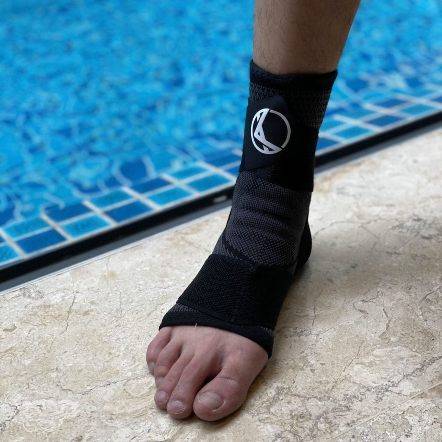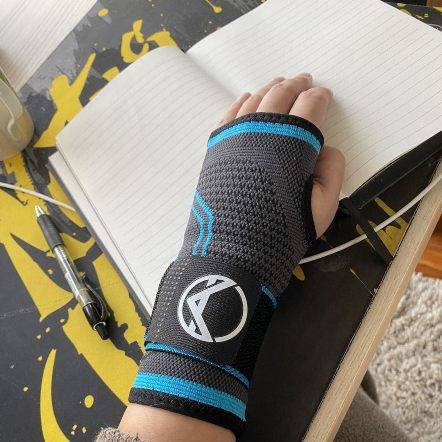
Compression Socks for Diabetes
August 5,2023 | 3 Mins Read
TABLE OF CONTENTS
1. Diabetes Leads to Circulation Problems and Swelling
2. Are Compression Socks Good for Diabetics?
3. How to Look for the Best Compression Socks for Diabetics?
4. What Is The Best Compression Level For Diabetics?
5. How Long Should You Wear Diabetic Compression Socks?
Swollen feet and ankles are just among the complications that are associated with diabetes. It's a chronic condition that affects more than 30 million people in the United States alone.
You can help reduce these symptoms with medical compression socks – a specialized type of hosiery that helps improve blood circulation and minimizes swelling. Learn more about compression socks for diabetes and how they can help manage symptoms.

When someone has diabetes, their body either doesn't produce enough insulin (Type 1 diabetes) or doesn't use insulin effectively (Type 2 diabetes). Insulin is crucial for regulating glucose (sugar) levels in the blood. When glucose levels remain high for a prolonged period, it can cause damage to blood vessels, nerves, and organs throughout the body.
Now, let's zoom in on the circulatory system. Blood vessels, like tiny highways, transport blood filled with oxygen and nutrients to all parts of our body, ensuring everything functions properly. However, in diabetes, high blood sugar levels can lead to a condition called 'diabetic vascular disease.' This condition affects the blood vessels, making them narrower and less flexible over time.
As the blood vessels become narrower and less pliable, blood flow gets restricted. The reduced blood flow can cause problems in different areas, including the legs and feet. The lack of proper circulation means that tissues in these areas receive fewer nutrients and oxygen, which can lead to swelling, or what we call 'edema.'
Edema, often observed as swollen feet or ankles, occurs when fluid builds up in the tissues. It can be uncomfortable and, in some cases, even painful. The restricted blood flow in diabetes can also make it harder for the body to heal wounds, increasing the risk of infections.
Compression socks can be beneficial for individuals with diabetes in alleviating edema (swelling).
By exerting pressure on the tissues, compression socks aid in preventing the accumulation of excess fluid (edema) in the legs and feet. The compression helps to push fluid out of the tissues and into the lymphatic and venous systems, allowing it to be more effectively transported and eliminated from the body.
The combination of improved circulation, reduced fluid buildup, and proper support for the veins helps alleviate discomfort and swelling associated with edema. Compression therapy can provide relief from symptoms such as pain, heaviness, and tightness in the legs and feet.
Medical-grade compression socks are the best choice for individuals with diabetes. They come in varying levels of compression, ranging from light, moderate, and strong. Below are some of the key features to look for in compression socks designed specifically for individuals with diabetes:

The best compression level for diabetics is typically 20-30 mmHg. This moderate compression provides ample support to the legs and feet, aiding in circulation while allowing freedom of movement and helps prevent DVT (deep vein thrombosis). It is also the most comfortable level of compression and can be worn all day with ease. For individuals who need more support, a higher-level of compression up to 40 mmHg may be beneficial. However, this should only be done under the advice of a physician or healthcare provider.
If you have diabetes, it's crucial to take special care of your feet and wearing diabetic compression socks is one way to support foot health. To get the most benefit from compression stockings, it is recommended to wear them during the day and take them off before going to bed.
The duration of wearing diabetic compression socks should generally be limited to a maximum of 8 hours a day. This allows for consistent support and improved circulation while giving your feet a break.
Living with diabetes requires proactive steps to manage your health and prevent complications. Swelling, or edema, is a common concern for individuals with diabetes, but there are ways to reduce the risk and promote overall well-being.
Here are some expert insights on preventing swelling:
At Koprez, we offer medical grade compression socks for diabetics that provide the right level of support and comfort. Our tigh-high compression socks are designed to help reduce swelling in your feet, improve circulation, and alleviate pain caused by diabetes-related discomfort. With our wide selection of sizes, you can find the perfect fit for you! Shop our collection today to find the perfect medical compression socks for diabetes.
References
Author

Claire Evans worked as the content marketing manager at Koprez. Claire combined a background of writing and editing, marketing, and patient education to best serve consumers, fitness enthusiasts, athletes, and anyone who relies on the Koprez brand for helpful information.
Koprez® Featured Products


"I sprain my wrist super often, so I decided to try out this sleeve. This is game-changing! I've been using it for a while now, and my wrists feel amazing. I haven't gotten in any injuries since using it too. It just makes my wrists feel so supported."
Alexis A.


"Use this for my boxing training. It is a very comfortable brace and does not move out of position during skipping ropes and sparring sessions. I use it while running too. Probably the best brace I've purchased throughout the years. It is very flexible. Makes me look like a pro! :)"
Samuel L.


"I've just got back to running after a couple of years of being plagued by injury. These compressions socks are helping give me peace of mind while I build up my distance again. They are the perfect level of compression, super comfy, and very high quality. Feel great while on a run, and looks great in the orange colour I have!"
Dave R.


"I have a weak ankle, and the Koprez ankle sleeve has been a lifesaver. Wear it every day. Super breathable and comfortable. Like wearing a cool sporty looking sock!"
James F.


"This is the best knee sleeve I've ever tried. It's now a must-have for all my exercises. A few years ago, I had an accident that damaged my knees, but with Koprez I can be active again with no knee pains at all. It's been truly amazing!"
Alex M.


"One of the best purchases I've ever made. It fits your legs all the way from top to bottom, great snug fit, gives you support and definitely helps during rehab and training."
Rafael A.


"I had a minor elbow injury, and Koprez sleeve was super supportive and definitely helped me recover faster. I still use the sleeve to prevent further injury. So far, so good. Very comfortable and does not feel hot at all. Highly recommend!"
Corey B.


"It's really been a game-changer for me. It allows me to exercise a lot longer than I used to. Now my knees don't hurt, and they're not uncomfortable at all."
Mike P.


"Great product!!"
Harold


"I have carpal tunnel, and this brace has helped me work pain-free. Love the materials, and I can feel my wrists slowly getting better, even when I don't wear them!"
Christopher J.


"I wanted to try out these sleeves to improve my squats and deadlift in the gym without worrying about injuring my knees. They stayed up throughout the entire gym session, and my knees feel super supported. Now I can do what I love for years to come. "
Corbin C.